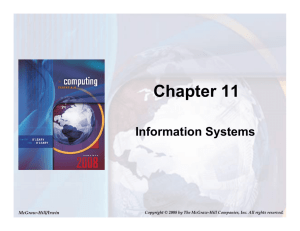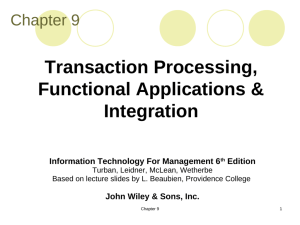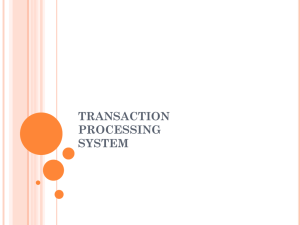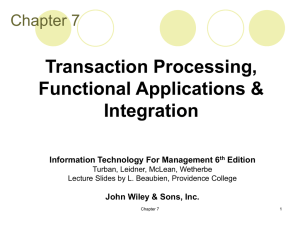Management Information Systems
advertisement
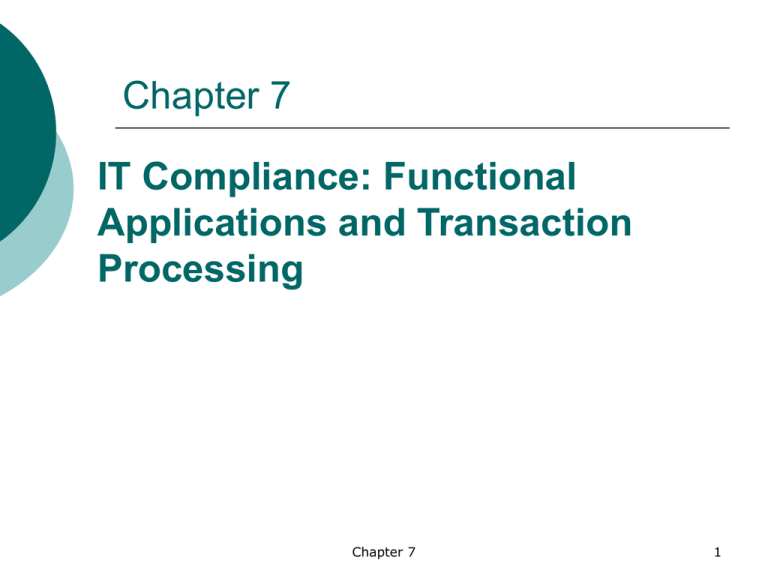
Chapter 7 IT Compliance: Functional Applications and Transaction Processing Chapter 7 1 Case study: Dartmouth-Hitchcock Medical Center The problem: problems of using nurse as supplies ordering person The solution The results Lessons learned Using IT to support the routine processes Chapter 7 2 Transaction Processing Information Systems In every organization there are business transactions that provide its mission-critical activities. Each transaction may generate additional transactions. Since the computations involved in most transactions are simple and the transaction processes are well defined they can be easily computerized. The transaction processing system Monitors Collects Stores Processes Disseminates information for all routine core business transactions. The primary goal of TPS is to provide all the information needed to keep the business running properly and efficiently. Chapter 7 3 Functional Areas in a Business •Compensation •Vacation •Skills/Training Human Resources •A/R •A/P •Payroll •General Ledger Accounting •Receiving •Fulfillment •Process control •Purchasing •Cash Management •Asset Management •Budgeting Business Funtion Operations Financing •Order Taking •CRM •Self-service Sales Marketing Chapter 7 •Retail Pricing •Sales Promotions •Sales Force Management. •Customer Loyalty •Interactive Marketing 4 Functional Information Systems Functional information systems support the organization, processes and business model. Composed of smaller systems: A functional information system consists of several smaller information systems that support specific activities performed in the functional area. Integrated or independent: The specific IS applications in any functional area can be integrated to form a coherent departmental functional system, they can be integrated across departmental lines to match a business process or be completely independent. Interfacing: Functional information systems may interface internally with each other to form the organization-wide information system or externally systems outside the organization. Supportive of different levels: Information systems applications support the three levels of an organization’s activities: operational, managerial, and strategic Enterprise Wide Environment – All business units. Chapter 7 5 Functional Information Systems Strategic Datamining ops that support management Dynamic and what-if features. Decision Support Back office administrative tasks and ops. Operation Level of the company is normally highly structured and predefined. Data Analysis and statistical forecasting. Office Integrated Clerical documents, schedules, mail, manuals, etc. Business transactions, events and processes. Support of the business and customers. Transactional Chapter 7 6 Transaction Processing Information Systems Chapter 7 7 TPS – Online Transaction Processing Systems With OLTP and Web technologies such as an extranet, suppliers can look at the firm’s inventory level or production schedule in real time. The suppliers themselves, in partnership with their customers, can then assume responsibility for inventory management and ordering. Interactive Internet TPS expands OLTP to provide enhanced real time transaction processing over the Internet or intranets. Multi-store chains can access a centralized computer system no longer requiring instore processors. Chapter 7 8 TPS – Managing Production/Operations & Logistics The production and operations management (POM) function in an organization is responsible for the processes that transform inputs into useful outputs. In comparison to the other functional areas, POM is very diversified as are the supporting TPS. It also differs considerably among organizations. A few of the IT supported POM areas are: In-house logistics and materials management Planning production/operations Computer-integrated manufacturing (CIM) Automating design work and manufacturing Chapter 7 9 TPS – Managing Production/Operations & Logistics Chapter 7 10 Managing Production/Operations & Logistics TPS – In-House Logistics & Materials Management Logistics management deals with ordering, purchasing, inbound logistics (receiving), and outbound logistics (shipping) activities. These logistical activities cross several primary and secondary activities on the value chain. Inventory management determines how much inventory to keep. Overstocking can be expensive; so are understock conditions. Manufacturing quality-control systems can be standalone systems or part of an enterprise-wide total quality management (TQM) effort. They provide information about the quality of incoming material as well as the quality of work-in-process and finished goods. Recall results of all inspections. Chapter 7 11 Managing Production/Operations & Logistics TPS – Computer-Integrated Manufacturing CIM is a concept that promotes the integration of various computerized factory systems. It has three basic goals: (1) the simplification of all manufacturing technologies and techniques, (2) automation of as many of the manufacturing processes as possible, and (3) integration and coordination of all aspects of design, manufacturing, and related functions via computer hardware and software. Typical integrated technologies are: JIT – Just-in-Time MRP – Materials Requirements Planning 一種決策技術用來決定何時採購何種物料多少量,以滿 足製造時的需求。 CAD – Computer Aided Design CAE – Computer Aided Engineering GT - Group technology Chapter 7 12 Managing Marketing and Sales Systems Channel systems are the TPS involved in the process of getting a product or service to customers and dealing with their needs. These systems link and transform marketing, sales, procurement, logistics, and delivery activities with other corporate functional areas. See Fig. 7.4 Some of the channel-system activities are: customer relations distribution channels and in-store innovations marketing management Chapter 7 13 TPS – Marketing channel systems Chapter 7 14 Marketing and Sales Systems TPS – Customer Relations It is essential for companies to know who their customers are and to treat them properly. Innovative products and services, successful promotions, customization, and customer service are a necessity for most organization. Customer Profiles and Preference Analysis. Sophisticated information systems are being developed to collect data on existing and potential customers, their demographics (age, gender, income level), and preferences. Prospective Customer Lists and Marketing Databases. All firms need to know and track who their existing and potential customers are. These prospectivecustomer lists can be analyzed and sorted by classification for direct mailing, e-mailing, or telemarketing. Mass Customization. Today’s customers prefer customized products. Through mass customization, manufacturers can offer different product configurations at reasonable prices. Personalization. Special product offers are made, based on where the customer spent their time and on what they may have purchased. Advertising and Promotions. Special promotions, coupons are presented to the customer via mails, email, wireless and pervasive computing applications. Chapter 7 15 Marketing and Sales Systems TPS – Distribution Channels & In-Store Innovations Organizations can distribute their products and services through a variety of delivery channels. IT-Supported Distribution Channels Internet Location Based Mapping Self-service convenience stores Improving Shopping and Checkout at Retail Stores Hand-held wireless devices that scan the bar code UPC Smart card or credit card Information kiosk enable customers to view catalogs in stores Self-checkout machines Computerization of various activities in retail stores Video-based systems count and track shoppers in a physical store Chapter 7 16 Marketing and Sales Systems TPS – Marketing Management Many marketing management decision applications are supported by computerized information systems. Pricing of Products or Services. Sales volumes are largely determined by the prices of products or services as is profit. Salesperson Productivity. Salespeople differ from each other in selling skill. Sales-force automation increases salesperson productivity by providing them with mobile devices, access to information, etc. Profitability Analysis profit contribution of certain products and services can be derived from cost-accounting systems Sales Analysis And Trends. Marketing TPS collect sales figures that can be searched for trends and relationships. New Products, Services, and Market Planning. New products and services can be an expensive risk. “Will it sell?” Requires careful analysis, planning, forecasting and Market research. Web-Based Systems support marketing and sales through data capture P&G example Chapter 7 17 TPS – Accounting and Finance Systems Accounting and finance functional areas manage the inflows and outflow of organizational assets. This involves all functions of an organization including payroll, billing, cash management, etc. Financial Planning and Budgeting Financial and Economic Forecasting Planning for Incoming Funds Budgeting Managing Financial Transactions Use proper software, such as SAP Figure 7.5 XBRL: Extensible Business Reporting Language Standard used to file financial reports electronically Chapter 7 18 TPS – Integrated Accounting/Business Software Chapter 7 19 TPS – Accounting and Finance Systems Continued E-Commerce Applications of Financial Transactions Expense Management Automation Investment Management Global stock exchanges and multiple currencies E-Bonds Factoring online: factors are financial institutions that buy accounts receivable, at a discount Financial Analysis Access to Financial and Economic Reports Control and Auditing Risk Analysis Budgetary Control Auditing Profitability Analysis and Cost Control Chapter 7 20 TPS – Human Resources Systems Web-based systems have increased the popularity of human resources information systems which provide applications mainly related to acquiring, hiring, rewarding, developing, training, protecting and retaining human resources. Recruitment is finding employees, testing them, and deciding which ones to hire. The Web has enhanced the recruitment process. Position Inventory HRM Portals and Salary Surveys Employee Selection Human Resources Maintenance and Development Performance Evaluation Training and Human Resources Development Chapter 7 21 TPS – Enterprise Wide Information Systems History Sales Analysis Profiling Bar Coding Accounting ERP SPARS SCM Receiving Point-of-Sale Service Purchasing Inventory Control Payroll Installations Integration of Cross-Functional Information Systems tears down barriers between and among departments & corporate headquarters and reduces duplication of effort. Chapter 7 22
